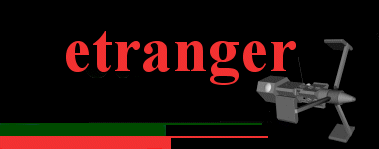
Richelieu Class
Battleship
By Bryn Monnery and Laurent Esmiol
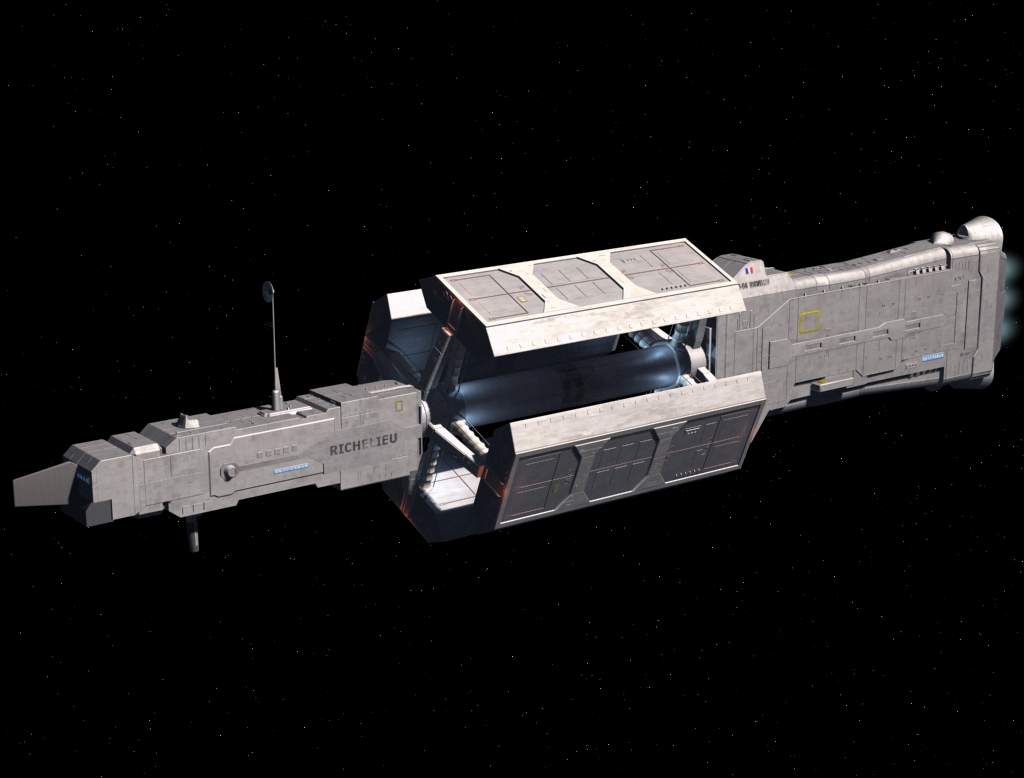
| Above:
The IFS Richelieu pictured
on trials in the Alpha Centauri system in 2293. The ship
is in cruising mode with spin habitat fully extended.
(Courtesy MSIF Media Ops.) Introduction The Richelieu Class of Battleships are the most powerful and expensive warships ever launched by humanity. They are capable of dominating any solar system with their combination of firepower, fighters and embarked troops. They are a very visible symbol of the power of the French Empire. However they have also taken the brunt of France's War against the Kafers and the Jeanne d'Arc and Tallyrand have both been lost to the aliens in the Eta Bootis system. In addition to the thousands of casualties these losses have sent shockwaves through French society, damaging morale and the prestige of the Empire. However the actions of the Richelieu, flagship of Admiral Rochemont, have helped restore the spirits of the French whilst leading effective opposition to the Kafer's assault on the French Arm. Acknowledgements This article is based on the Richelieu class ship described in GDW's Ships of the French Arm and Aurore books. |
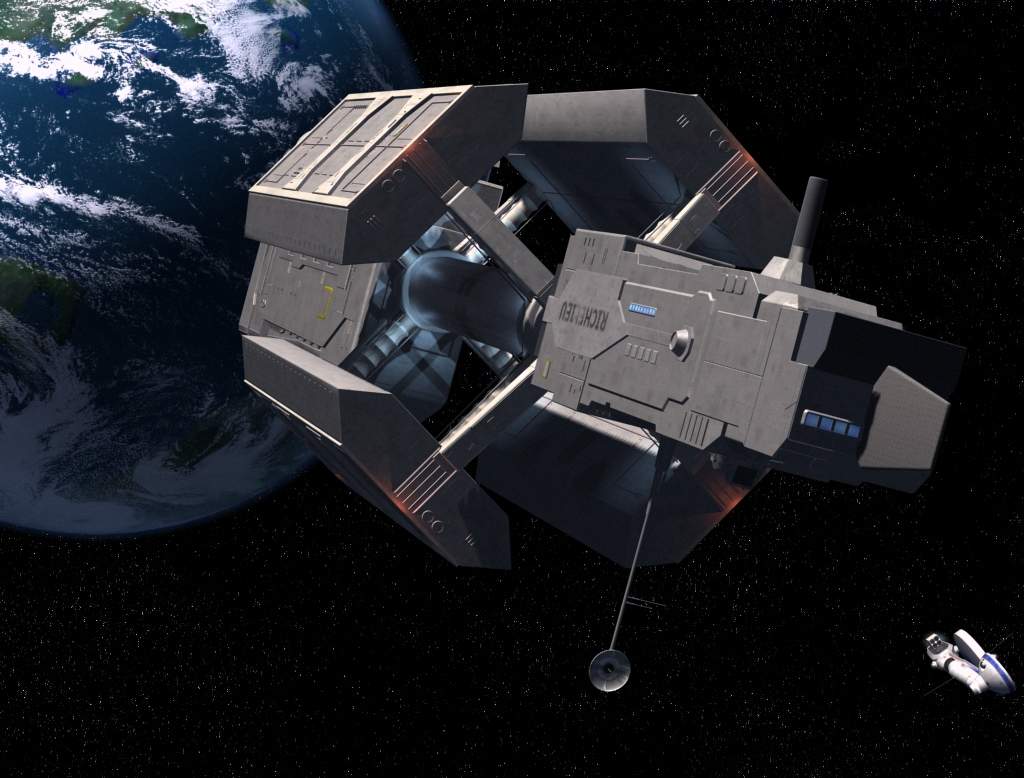
| Above:
IFS Richelieu
departing Earth orbit for the French Arm in 2298.
(Courtesy MSIF Media Ops.)
The Battleship is the ultimate power projection platform, and hence arbiter of power. The French have many large ships, we have a few smaller ships, hence the French are the dominant power. To become a major power, we must be able to project power and this requires we have Battleships. Without them America will remain a second rate power. To challenge France, we must become like France. - Admiral Lisa Ekhart, Address to the Graduating Class, USSF Academy Colorado Springs In the 2260’s warships were still very much gunships, designed to fight at 'close' range with a direct fire armament. Missiles had first been demonstrated back in 2205 when 3 Brazilian missile frigates attacked the Argentine squadron defending their Tirane colony of Santa Maria. These weapons were not the panacea that some thought, they could strike targets at a distance but they only carried a single laser and were generally ineffective. Consequently ships were built with heavy beam batteries, and combat was fought mainly at 'broadsides', and the missile was a minor tactical concern threatening only to minor ships. In the 2270’s Argentina and Brazil fought another war, the first real "Interstellar" war, fought throughout human space, both sides had developed a new weapons system in secret, this was the nuclear detonation warhead. The detonation warhead gave missiles a heavy punch and a raison d’etre, and it seemed the age of the large Battleship was over. The French, however, had other ideas. They had pioneered new capacitor technology in the 2270’s and the Ritage missile is the most advanced conventional missile in existence. It was decided to continue with this development of this weapons system and its deployment would become widespread in the fleet, although later supplemented with detonation laser missiles. In the meantime Central Asian War experience showed that the heavily armoured gunship was still a viable combat unit and work was commenced on the largest Battleship class ever produced, the Richelieu. |
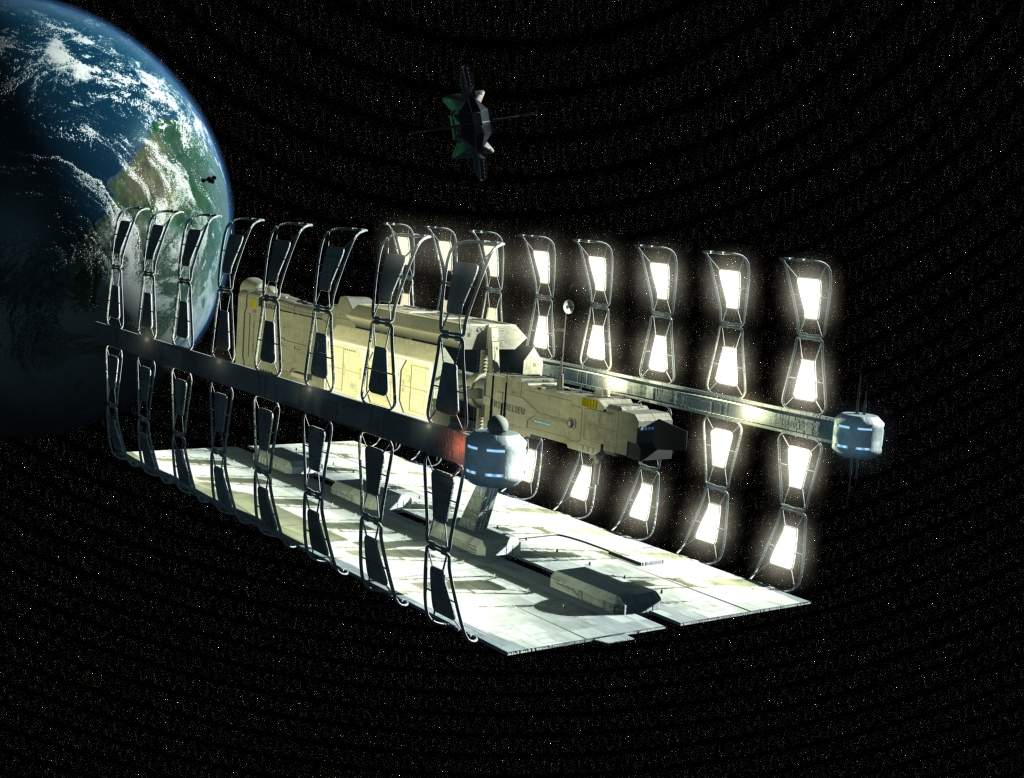
Above: The Richelieu under construction above Tirane in 2290. These advanced and highly complicated ships have an exceedingly long construction time. It was at this dock the newly started ship was damaged by a daring raid by Manchurian commandos in 2286. (Courtesy Rouchard-Ligget Press Office.) Future Trends in Battleship Design French, British and Bavarian Battleships prior to the Richelieu were fairly similar. They used the same 300MW fusion plant, carried roughly the same number of fighters, missiles and guns, had heavy screens and armour. The Richelieu upped the ante, with a larger, custom built fusion plant and heavier weapons loads. It was substantially more expensive than its predecessors and coupled with the introduction of new technology forced the price of ships higher than Britain and Bavaria could afford. By the time the Richelieu was completed Bavaria was part of the united Germany, while America, Japan and Manchuria were embarking on a Battleship building generation of smaller, faster and programme of their own. These nations realised that the introduction of new weapons meant that the large Battleship was being superseded by a new cheaper Battleships. These are often disparagingly called Battlecruisers, a name which is actually a nonsense as these vessels are true Battleships in every way. Table showing the major powers' latest generation of Capital Ships:
The Commander of a Richelieu is a Capitaine de vaisseau (Captain) who commands the ship proper. As most vessels of this class are used as flagships, an Amiral of some grade along with his staff are present, who command the squadron although the flagship itself remains firmly under her master's command. The XO is a Capitaine de frégate (Commander), who is fresh from commanding a destroyer, and probably destined for command of a large line of battle ship (a Cruiser or Battleship). The commander’s right hand man is a Major (the senior Warrant rank), who is usually the "Navigator-2", while the Navigation Officer is a Lieutenant de vaisseau on the command (Enseigne de vaisseau de 1re classe, whose promotion to Capitaine de Corvette will bring a frigate command. There are 4 other "bridge officers", the 2 Operations Officers classe) and 2 Computer Officers (Enseigne de vaisseau de 2e classe). There are 26 enlisted men on the bridge, ranging from the Major to the lowest Maistrancier. The CT (Tactical Centre) controls the 36 laser turrets, 8 missile launchers, up to 12 fighters and the sensors. There are 2 officers here, commanded by the 3rd Officer (Capitaine de Corvette) and the fighter commander (generally a Commandant (Squadron Leader) or a Lieutenant-colonel (Wing Commander) if an enlarged group is being carried). The remainder of the crew are ratings. The 244 engineering crew commanded by Capitaine de frégate with 6 shift commanders (Enseigne of either rate) and his XO (Lieutenant de vaisseau). The 160 men steward crew are all non-commissioned and are fairly junior, while the Medical staff is full of commissioned officers; Surgeons, Nurses and so on, staffing a full surgical centre. The Richelieu can carry over 1000 troops, making it capable of seizing the largest space stations or intervening decisively on a planetary surface. Normally far fewer troops than this are carried, usually from the Fusiliers-Voltigeurs Marins Spatiaux (Space Naval Light Infantry) attached to a specific fleet. However when required a battlegroup from a TIS Brigade d' Intervention can be rapidly embarked, normally including a battalion of Marine or Legion paratroopers, half a battalion of combat walkers and support elements. Life onboard is difficult for those not accustomed to it. As on all starships with large populations, everyone shaves their heads to avoid both zero-g problems and hairs clogging the life support system. There is an obsession with cleanliness onboard a Richelieu, the top layer of skin being scrubbed off in the showers every day, and everyone wears shipsuits. These are skin tight mechanical counterpressure suits, coloured to ships branch (dark blue for bridge/ TAC crew, light blue for the commissariat, dark red for the medical and grey for engineering). The embarked troops are generally confined to the spin capsules, and allowed to wear barrack dress. |
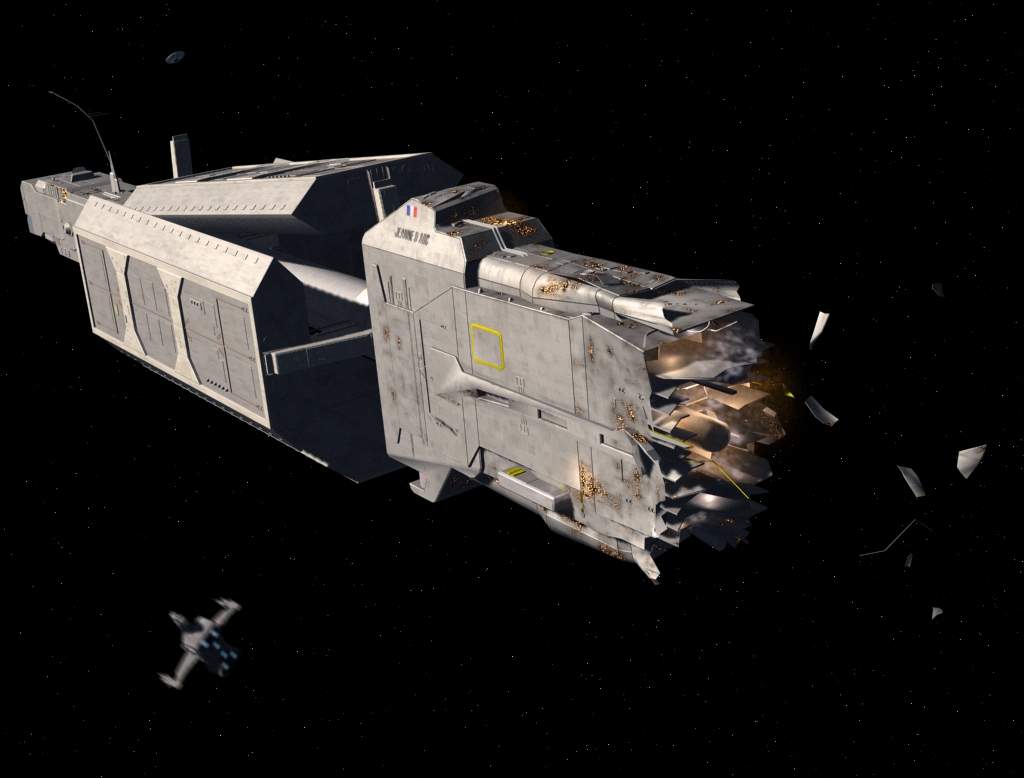
| Above:
'The Day that shook the Empire'
- 6th April 2298. The IFS Jeanne d' Arc is
destroyed by the Kafers whilst defending Aurore.
(Courtesy DSKM .)
The Richelieu is the largest warship ever produced by humanity and the most powerful. The main power plant is a 415MW fusion reactor, the largest reactor ever built. This consists of a two large toroidal particle accelerators which smash constantly replenished streams of deuterium together, liberating vast quantities of energy. This in turn powers the largest stutterwarp drive ever built, consuming 300MW of power, this drives the huge vessel at a high speed. The weapons system is impressive, 36 armoured turrets each mount 2 x1+1 lasers with a UTES, equipped with the most modern fire control systems. Although designed without missile weapons, they were converted to carry missiles. Currently they have 16 Ritage-2 in bays, and 2 missile packs, usually carrying the Ritage-1. The hull is moderately armoured, and a powerful screen system is installed. Sensors include a full long range and survey suite, while the tactical sensors are the most powerful available to humanity. Beyond "visual range", the Ritage-1 missiles are used as an inner screen, their sensor systems give long range warning, surrounding the ship with a screen of sensors and weapons. Beyond this, the embarked fighter squadron can be used to scout and strike well beyond the reach of the carrier. In addition, drones may be carried, but generally only for special duties. For ground operations, there is a large bay, which may carry at least 6 landers, but often these are doubled up. These can land at least 2 companies of troops, generally special forces or recce troops who provide surveillance coverage for the carrier in areas satellites can't reach. The amount of ground strike ordnance carried by a Richelieu is horrifying, in extremis over 2 million kinetic harpoons may be carried, enough to level dozens of cities. Accommodations consist of four capsules which are extendible and spin once every 10 seconds. This provides 0.6g when retracted and can be extended to give a full 1g, allowing for fitness to be maintained. This can cause "space sickness" in some non-spacers. Life support is a based on a recycling system. Food is the only requirement, as the fusion plant provides sufficient power to maintain the atmosphere and temperature, while the water is completely recycled. However, should the fusion plant fail, this means that the crew will only survive until the emergency power runs out (roughly a week). Should all else fail, the crew can abandon ship. This is very much a last resort, as their life expectancy in a rescue ball is a day at best. If the ship fails in between systems, their only hope is the emergency beacon. This transmits a loud squawk across the frequency range, however, the area of the distress call is only 2% of a light year. If on the main shipping lanes, there is a reasonable chance of rescue, however, if doglegging, chances are next to nothing. The Richelieu is a powerful fighting ship in it’s own right and a means of projecting power anywhere. It is a potent flagship capable of overcoming most obstacles placed in its way. When trouble develops, the first question the Emperor asks is "Where is the Richelieu?". |
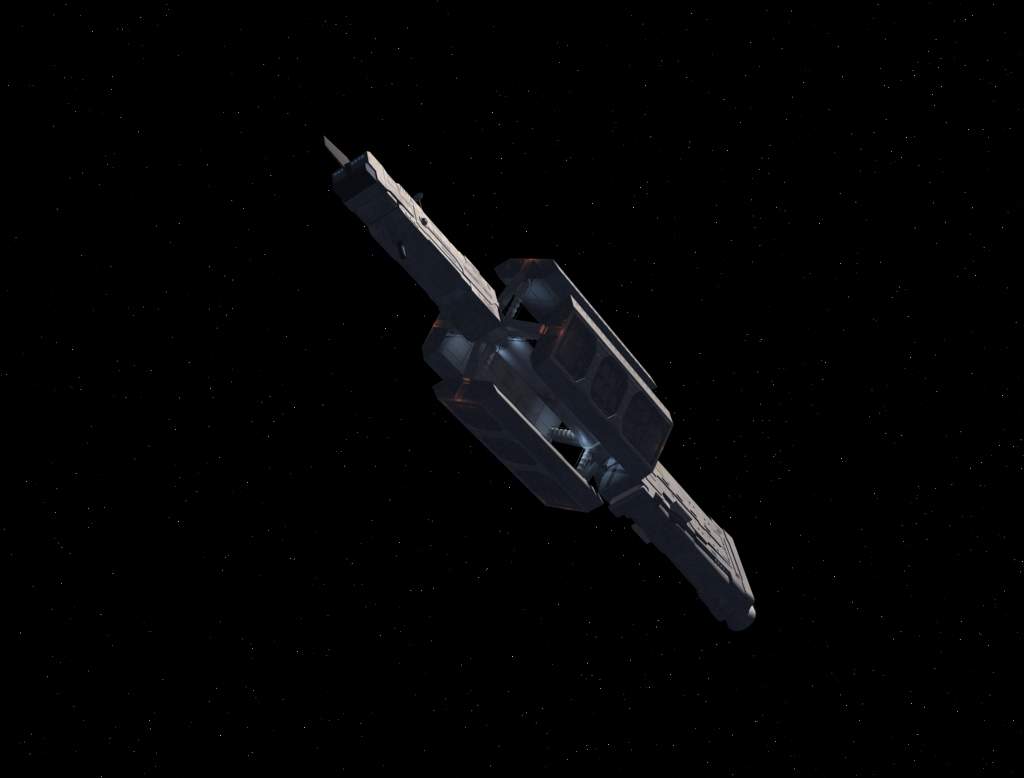
| Above: IFS
Tallyrand in the Eta Bootis system
during 2300. (Courtesy MSIF Media Ops).
There have been 4 vessels in the Richelieu class, Richelieu, Talleyrand, Jeanne d’Arc and Napoleon, and another (Clemenceau) under construction and due to commission in 2302. Construction was commenced in 2285, during the Central Asian War, but was subjected to a Manchurian commando raid based out of Tunghu, and construction was delayed. Two sisters, Talleyrand and Jeanne d’Arc were laid down in 2287 and '88 respectively. Both were subjected to numerous delays and none were in commission prior to the German War. They were commissioned in 2293, '94 and '95 respectively. At eight years they were seriously overdue. Another two were laid down, while the dock for Richelieu was used for the Joffre, humanities first dedicated fleet fighter carrier. These two were slated to replace the old DeGaulle class, but the current crisis, and the losses in the Kafer War will see these units retained, probably after replacement Battleships have been procured. Richelieu has since rotated through the fleets as flagship, and was Vice Amiral Rochemont’s flag for the 3e Flotte and then the Combined Strike Fleet, a massive formation comprising 4 carrier ships (Richelieu, DeGaulle, Bayern and Graf Zeppelin), 17 line of battle ships and 21 frigates. French, German, British, Japanese, Americans, Australians and Elysians working together to liberate the French Arm. Together with the Reserve Fleet (7 carriers, 34 battle ships and 27 frigates) and the Aurore Fleet (3 carriers, 8 battle ships and 8 frigates) they continue to bring the battle to the enemy. Flag of Vice Amiral Rochemont’s 3rd Fleet and based at Beta Canum, the original Richelieu completed a refit at BCV’s French Orbital Terminal just prior to the Invasion. Like all starships, the stutterwarp drive requires periodic rebuilding, or drive efficiency suffers. The Richelieu has just completed a rebuild and so is at absolutely top fighting readiness. At the same time she was upgraded to the same standard as her sister ships. When the Kafers invaded, the 3rd Fleet was dispersed, with the core at Beta Canum. Rochemont immediately set about organising a counterstrike, convincing the RSN and DSKM squadrons to join in what was to become the First Relief Expedition. This powerful grouping moved down Arm, linking up with the Terran forces at BCB. With a force consisting of the Richelieu itself, the German Admiral Hipper, 8 smaller line of battle ships (Suchet, Foch, Ney, Seydlitz, Lutzow, Defiance, Indefatigable and Renown) and 10 frigates (Austerlitz, Imperieuse, Tonnant, Castiglione, Brandenburg, Leipzig, Achates, Ulysses, Andromeda and Medea). This force of squadron to guard BCB while 13 other ships pushed forwards towards Aurore. 20 combat starships contacted forward elements of the Kafer fleet, defeating them in the 1st Battle of BCB (22-25/8/2301), the combined fleet left a strong Anglo-German squadron behind to secure the system. On 16/9/2301 the Richelieu and her fleet sighted a much larger Kafer force in the Hochbaden system and Rochemont decided to withdraw, consolidating at BCB, only arriving to find that his lines of communication squadron had been defeated and the Kafers were in possession of the system. They had to fight their way back to Vogelheim, regrouping there and turning to repulse the pursuing Kafer squadron. In the first week of November, the squadron sortied again, only to be defeated by superior Kafer numbers at Hochbaden, withdrawing with the fleet largely intact. Rochemont developed a much more sophisticated plan, co-ordinating 2 fleets, his own and the 5th Fleet, reinforced with new German Battleship Guderian. The 3rd Fleet, occupied the garrison, while the 5th Fleet warped through to Aurore, escorting a large force of transports. Fortunately, the Kafers had initiated their make or break Aurore offensive, and this force (especially the missiles carried on the transports) gave the Terrans a sufficient edge of win. In mid February the fleet defeated the Kafers again at Vogelheim, and shifted to Grosshiddenfaden, while the Anglo-German squadron remained autonomous under British command. This force of 30 combat starships brought TF Yankee to Battle in the Grosshiddenfaden system and smashed it. It then pushed on to Joi, counter-attacking along Japanese, German and Elysian elements which had withdrawn, allowing the Kafers to invest orbit. Trapped in close orbit landing troops the Kafer force was at a tremendous disadvantage and heavily defeated. This massive force secured the systems of Joi, Crater and disputed control of Beta Canum Venticorum until the colony was finally secure. However there were never enough troops with the fleet to secure the surfaces of these worlds despite Rochemont's 'liberation' rhetoric. Subsequently Rochemont did not manage to bring his fleet to Kimanjano as a blocking force in the aftermath of the Battle of Beowulf, but did aid in the securing of the Arm in spite of many of his ships being taken away to assist in the landing of troops from Earth on the disputed worlds. Currently, Richelieu is at Kimanjano, commanding the campaign to clear the Eta Bootis finger from there. Plans to move down Arm and make major landings on other Kafer infested worlds are afoot. Contre Amiral Bertrand’s flagship at Aurore. Bertrand was an experienced officer and one of the finest ship commanders and administrators the MSIF ever produced. He was not, however, a Fleet commander of any distinction. Bertrand commanded the forces retaking Aurore from the Talleyrand in 2298. His forces were substantially superior than those Du Boise had a few months previously. Overall he attacked with 2 flagships, 3 line of battle ships and 6 frigates, mostly equipped with modern weapons. The Kafers lacked major repair facilities and the Jeanne d’Arc had destroyed a third of their fleet. It was a short and bloody battle before the Kafers withdrew. In the following pursuit, the Bismarck contacted and destroyed a heavily damaged Beta in the rings of Laodemon. With the Kafers in retreat, an American squadron arrived and decided to mount a probe into the Arcturus system against the advice of Bertrand, who wanted to go in force at a later date. Rear Admiral Parker took his 2 Kennedy-class ships into the system anyway, meeting a single enemy battle ship which destroyed the USS Sanchez and heavily damaged the USS Jefferson, which withdrew leaving the Kafers controlling the field. Bertrand’s forces mounted their own probe the following year, using the IFS Bassompierre to insert a mixed team of French and American marines. This force recaptured Station Arcture, but failed to hold it and withdraw back to Aurore. Bertrand’s authority was increasingly shaky, with Kommodore Lutke prominent amongst the national contingent commanders in questioning his every move. On hearing of the Kafer Invasion of Hochbaden Bertrand set about organising a relief with great energy, shifting forces to Hochbaden and attacking the Kafers immediately on entering the system. However the German Kommodore Lutke decided on a more cautious approach, hanging back to leave the French and Americans to engage the Kafers alone and maintaining his force as a reserve. Talleyrand was swiftly overwhelmed by swarms of Kafer ships, and suffered several hits, damaging her drives. She was lost with all hands, although when recovered in mid 2302 many bodies were unaccounted for, including Rear Amiral Bertrand. The valiant Jeanne d’Arc headed the 4th fleet assigned with securing the borders of human space against the newly contacted Kafers in 2296. She was the flag of Vice Amiral Du Boise, knowing that his resources were limited he committed his forces to the defence of Aurore and refrained from probing Kafer space, which would leave Aurore vulnerable. Many armchair analysts saw him as lethargic, nothing could be further from the truth. Du Boise went to great lengths to secure the Frontier, however aside from his own flagship he only had 6 other line of battle ships; the Suffren, DeGrasse, Konstantin, Kiev, Rostov and Sevastapol. In addition he had 4 frigates: Aconit, Duperre, Kersaint and Vauquelin. The 3 French battle ships were excellent, and the French frigates were very useful, but they were all still awaiting the delivery of the new Ritage-2 missile. The 4 Ukrainian units were very old indeed, being pre-2250’s French units decommissioned and sold off. Also coming up were an additional French battle ship, 2 Ukrainian frigates and a German Battlegroup but before any of this could arrive the Kafers entered human space and struck The battle which followed has to be the last "pure gun" battle in history. Triumphant Destiny brought its most powerful squadron to war, 3 Alphas and 4 Betas. In terms of numbers and in combat power this may not have been enough, but the element of surprise was on its side. The French cruisers of DC-2 were first to contact the enemy as they were on patrol in the outer system when the enemy fleet entered it. Moving to intercept, they found themselves cut off and destroyed. A small convoy was leaving the system and two Ukrainian ships was escorting it, they too were cut off and destroyed. With the loss of these four ships, Du Boise's fleet was all but crippled. He resolved to hold orbit, hoping that the enemy would be deterred and send for reinforcements, while his own substantial reinforcements were already en route. This was not to be, and the Kafers attacked, Du Boise countered as best he could, fighting a Broadside-Broadside battle around the planet placing his ship alongside the Kafer flag. It could have been a stunning victory, it wasn’t to be. Jeanne d’Arc, the pride of France, was pounded to death. Her commander refusing to give way and let the enemy reach the colony. She was, of course, fast enough to outrun any starship in the invasion force but she didn’t. With the Admiral dead, she signalled the Konstantin to take over and regroup at Hochbaden. Borodin ordered the fleet to break off, every ship for themselves while the Jeanne d’Arc covered their retreat. She was still in a far orbit of Aurore when humanity retook Aurore, completely open to the Vacuum and beyond salvaging. She was towed back to Earth, out of the reach of the Kafers and designated a war grave. The line of battle ship IFS Du Boise (Improved Suffren class) was laid down in 2299, while a new Jeanne d’Arc will be commenced in 2302. Replacing Talleyrand at Earth (Talleyrand replaced Jeanne d’Arc when she was lost), the newly commissioned Napoleon is the flag of the 1st Fleet. The 1st Fleet is the main Earth based reaction fleet, and is ready to deploy to any corner of human space at a moments notice. Currently under construction and due to be commissioned by the end of 2302. R-18 will be a new Jeanne d’Arc. |
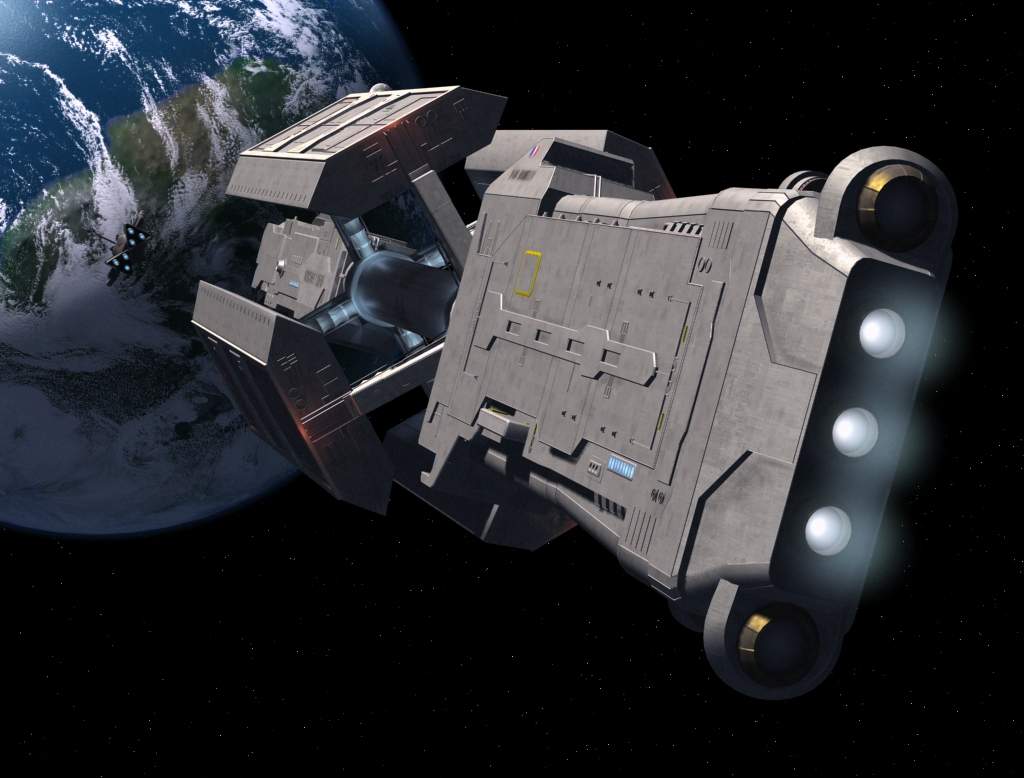
Above:
With a close escort of Martel
fighters, a Richelieu (actually the Napoleon)
approaches Tirane orbit in the Alpha Centauri
system in the summer of 2300. The censor has obscured the
name and pennant number of this ship for security
reasons. (Courtesy MSIF Media Ops.)
Performance
Ship Status Sheet
|
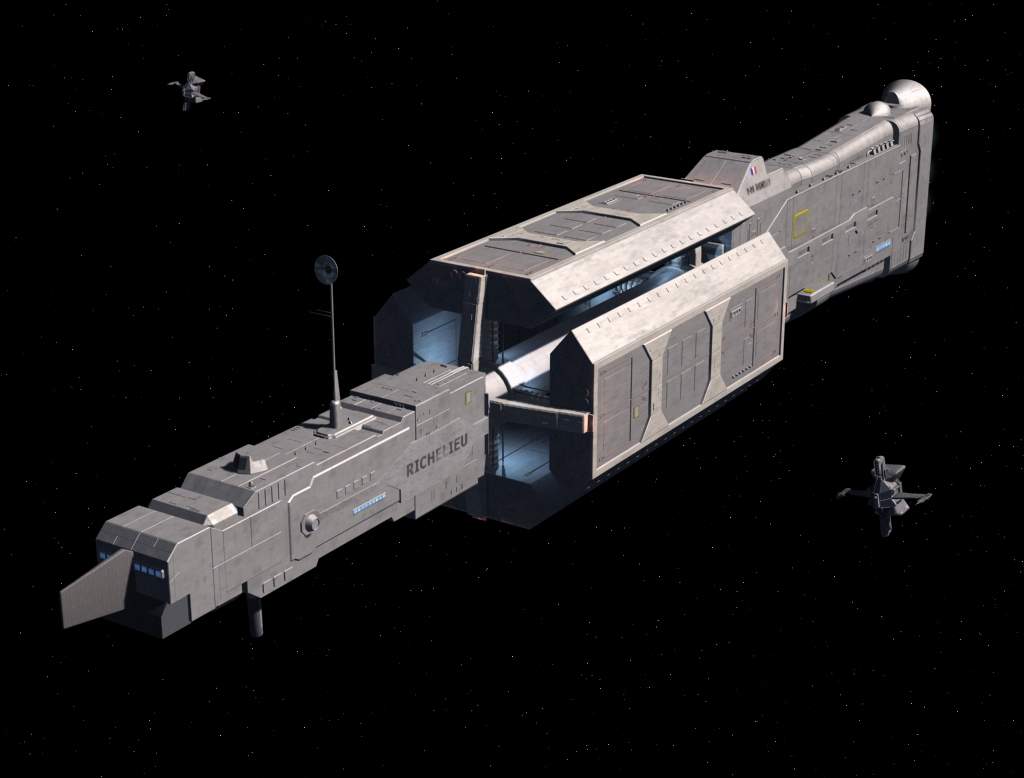
| Above:
The Richelieu in
the Vogelheim system prior to the 1st Battle of BCB. The
escort is of Martel fighters from 2/1 ECSE. (Courtesy
MSIF Media Ops.)
The design is based around the hull as shown, and the basic Richelieu/ Talleyrand design. I found that assuming the hull form and size are correct, it uses length x beam to determine lateral profile. This drops to +4 if only the actual "filled space" is used. The engineering section has been based on the size required to give the correct number of DC personnel. For those with a "carrier" bent in their campaign, the Richelieu can carry a fairly large number of fighters. A full "deck load" would be 24 Martels, by dropping the landers and doubling up in the bays (the landers and fighters can be interchanged 1 for 1). Even without the extra craft, the Richelieu fills the "Carrier" role in the space forces. Carriers today are much more than anti-shipping platforms, a job which surface ships and submarines actually do better now with the introduction of long range anti-shipping missiles. They can project power ashore, which is what Richelieu can do. It can provide bombardment on a variety of scales, from pinpoint strikes against chosen installations to full salvo city levelling, it can project troops down. Each French Battleship can be assigned a strong battlegroup of elite interface capable infantry. |